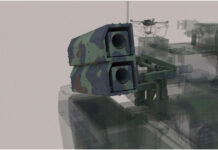A new Enterprise Resource Planning (ERP) Information Technology solution designed by SAP is providing end-to-end management of logistics aspects by modern military forces. The new suite of applications support the management and monitoring of units, personnel and equipment readiness, from mobilization through deployment, on a local or global basis. The system also provides readiness status of such assets to other command and control information systems where it is integrated into the planning and operational decisions.
According to Major General (USAF Ret) John Barry, VP Defense & Security at SAP, the new system provides horizontal integration of logistics management which boosts the capability and availability of the entire organization. By applying such technology, units gain more flexibility and better visibility of their available assets. By improved maintenance, training and inventory management, the become better prepared, their planning process is more efficient and the entire response is more flexible – as they become better equipped for modern asymmetric war against terror. With the total visibility to every unit and combat element provided by the system, military commanders can monitor the status and readiness of units and combat related assets, “from foxhole to factory”.
An important addition introduced in the Defense & Security system is the support of mobile infrastructure technology, which was added as a component of the SAP NetWeave software integration platform. This component enables the execution of field operations, independent of a direct connection to a central SAP system. The system can be deployed in the field, and will synchronize with geographically distributed resources once communicating is established, over satellite links, combat net radio networks as well as line or wireless links. The mobile functionality of the system provides all command levels an end-to-end management and monitoring of units, personnel and equipment throughout their contingency. The system operates with standard laptops, PDAs and PCs. The system supports modern, advanced information gathering and tracking utilities, such as barcodes, RF ID tags and other automated tracking and reporting systems, for improved performance and information delivery.
In the US Army, the Global Combat Support System planned for initial deployment in FY 2006, will replace 14 major logistical applications built specifically for military use. The SAP system is utilizing commercially off the shelf (COTS) software tools, widely used by the industry, commercial sectors and governments worldwide. SAP already supports more than 14 NATO member country governments currently running SAP solutions. SAP for defense & Security is being integrated with several armed forces, including the US Army, Norway, Denmark, German Army (the Bundeswehr), the U.S. Navy which uses SAP for managing its shore based logistical activity, and the Israeli Navy which uses the SAP portal for integrated information and decision support for the navy command level.
Utilizing the SAP NetWeaver application infrastructure, the new system can be integrated into an existing environment of legacy systems. By transforming data from multiple independent systems the SAP system eliminates “islands” of data, contributing to improved visibility, usability, accuracy and security of valuable information resources. Integration of external business, financials, human resources, supply chain and logistics is also handled by NetWeaver.
Two features derived from the business sector are are promising to improve savings and safety in military activities, especially during training and routine operations. One such benefit is the mapping of assets against liabilities, ensuring that effectiveness is not compromised. Identifying ineffective assets and simulating potential alternatives can save significant resources, when budget cuts are required. The system also provides total asset visibility which contributes to reduction in inventories, procurement and warehousing costs, while allowing for better concentration of limited resources, especially where the military user is handling logistics and support. When outsourcing such services, the system can easily link with commercial service providers, by data exchange among partners such as government agencies, coalition forces and suppliers. Another aspect of this application is the management of operations with consideration of specific procedures and guidelines, which improves the performance of supply chains, suppliers relations and coordination between supporting forces. While such limitations could be binding for the management of combat operations, they are very important at peacetime and during training exercises, to ensure safety levels and maintain operations within a set budget.



















